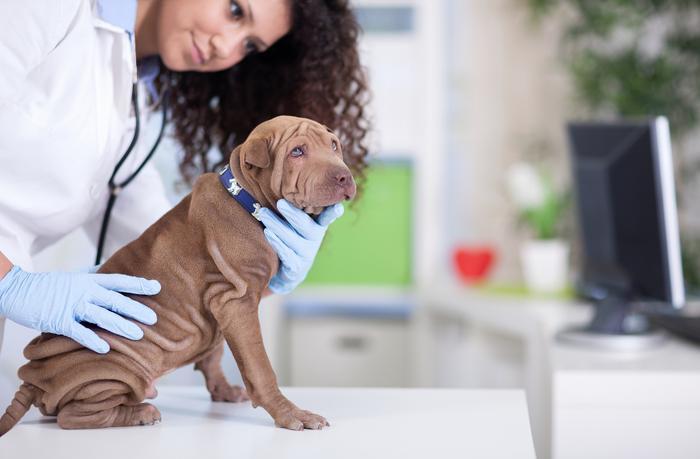People often say that veterinarians have a much harder job than human doctors because they can’t ask their patients about what’s ailing them. This can certainly hold true for a pet parent who frequently asks us: What can I give my dog for pain? After all your dog can’t approach you to tell you about a sour stomach or a painful leg like your two-legged kids can.
From vomiting to lethargy, these things can mean a variety of problems. As always, when in doubt, you should take your dog to the vet because there isn’t much that can be treated safely at home.
Below are a few common tell tails your dog is in pain or just sick. As you will notice, most of them are Irritable Bowel Syndrome (IBS) which is more often than not, caused by diet.
The founder of Farmer’s Dog (a homemade dog meal prep service) started his company when his rottweiler was diagnosed with IBS. Within a week of giving his dog a natural cooked food diet all his stomach issues went away.
But he is not the only one. Many have discovered that when feeding their dog quality cooked food instead of dry or canned foods they become happier dogs. Less joint pain, stomach pains, allergies, and so on.
Now, let’s go over the most common symptoms of pain…
Contents
Dog Vomiting & Diarrhea
Dogs are known for eating any assortment of disgusting or weird things found on the ground. Sometimes too much grass or a rummage through the trash can lead to your dog vomiting right in the middle of the living room carpet, but when should you be worried and not rely on your K9 first-aid kit?
Is your dog vomiting?
Generally, one or two episodes of vomiting isn’t worrisome. But when the vomiting extends into a series of upchucking, your dog should be seen by a vet, its what they do best, diagnose animals in pain. It’s critical to have them seen if they’re vomiting immediately after eating or drinking as it could be the Corona virus.
That could mean your dog has eaten something (a rock, sock, or a portion of their toy) and it’s lodged in their intestines. Other signs will be extreme lethargy, an inability to defecate, a hunched back, and a painful abdomen. Just like in human intestines, in our four legged friends, an intestinal obstruction is always life-threatening, if it isn’t treated right away.
If your dog is a chronic object eater or you’re noticing any of these symptoms, don’t wait until tomorrow to take your dog in. Call your vet, explain you’re worried about an obstruction, and they’ll get you in immediately.
Watch this video for common dog stomach aches symptoms:
Does your dog have diarrhea?
Another common reason for vomiting is trash rummaging. It’s a long running joke that dogs like to eat trash, but it can actually be quite serious. Trash isn’t clean, and rotting food can harbor massive amounts of bacteria that can make a dog quite ill. Depending on what they’ve eaten, they can also wind up with pancreatitis, a very painful inflammation of the pancreas. Common symptoms of garbage gut include lethargy, uncontrollable diarrhea, loud intestinal noises, stomach pain, and a lack of appetite. Treatment is usually effective and requires a round of IV fluids, pain medications, and antibiotics during their hospitalization.
Dog dehydration symptoms:
Excessive vomiting leads to dehydration quite quickly. If you come home to multiple surprises scattered throughout your house, you can evaluate your dog for dehydration. First, check his gums. They should be moist and slightly tacky to the touch with a healthy bubblegum pink color. If they’re dry or pale in color, that warrants an immediate vet visit. You can also check his skin turgor. Pinch the skin between his shoulders. It should immediately go back to normal; if it remains tented after you’ve let it go, that means there’s significant dehydration taking place and they need veterinary attention immediately.
Dog Pain – How Bad Can It Get?

Soup, please!
Signs that require rapid medical attention:
Unlike dog skin problems, if you notice any of these symptoms, it’s typically an emergency and your dog absolutely needs medical care ASAP:
- white or pale gums
- listlessness or lethargy
- excessive vomiting or diarrhea, especially immediately after eating or drinking
- inability to walk
- muscle tremors
Don’t ever underestimate any weird symptoms your dog is showing. It’s better to go to the vet and have it be nothing than to avoid the vet and find out later it was a treatable if they were seen immediately.
Physical Pain (hip, back, legs)
Rambunctious dogs can be quite prone to leg injury. Tiny dogs jumping off the furniture are quite commonly seen for leg injuries. If you notice your dog limping, it doesn’t necessarily indicate a broken leg, but it is possible. Whether they’re limping or they’re completely non-weight bearing, they should be taken into the vet for a thorough exam and x-rays. Its what they get paid for after all.
The biggest thing to take away from this, however, is to never give your dog pain medication from your own medicine cabinet!

This dog couldn’t be luckier for having a caring vet take care of it’s pain & suffering.
Pain Medication
What can I give my dog for pain relief?
Human pain medications like Tylenol and Advil don’t react with a dog’s pain receptors, so it won’t help with their pain at all. Secondly, dogs don’t process these types of medications like humans do. Even small doses of human pain meds can lead to severe liver damage and even liver failure.
Dogs who were given just one dose of human pain relievers have required days in the hospital and their livers never quite recover. So please don’t experiment on your dog with pain killers, they have their own. After all, animal care is a school of its own.
Here are a few Nonsteroidal anti-inflammatory drugs (NSAIDs for short) that a vet might suggest as safe with minimal side effects:
- carprofen (Novox or Rimadyl)
- deracoxib (Deramaxx)
- etodolac (Etogesic)
- firocoxib (Previcox)
- meloxicam (Metacam )
- tepoxalin ( Zubrin)
If your dog has an bad and adverse reaction to any of these let you vet know immediately!
Gastric Dilatation Volvulus (GDV or Bloat)
Bloat is mostly seen in deep chested dogs like labs, German Shepherds, and standard poodles. The dog’s stomach inflates with air, swells, and then rotates and flips, cutting off the blood supply to the stomach. The only treatment that works is surgery, and some dogs don’t survive surgery. Signs of bloat include a bloated abdomen, pale gums, panting, vomiting of white foam, and an inability to walk.
Some dogs bloat from gorging on food or trash, others bloat after drinking copious amounts of water after exercise, and some dogs bloat for no known reason. This is a highly deadly medical condition, and even rapid medical attention doesn’t guarantee survival.
Ways to Get Help
If you need financial assistant there are many organizations that you can reach out to for help, including my favorite, which has a network of quality vet clinics at a reduced price with their membership plan. Otherwise, I would suggest getting pet insurance before another occurrence. It can’t do you much good right now, but if your dog is susceptible to pain then there is a good chance you will need a policy going forward.







